12 Mar 2013
The Ghosts of Shoppers Past: why assumptions matter
Berry Pomeroy Castle near Totnes is famed for supposedly being one of the most haunted castles in Britain. It is said that the ghosts can still be seen of the Pomeroy brothers riding to their doom over the castle cliffs to avoid losing the castle following a siege. Or there’s the Blue Lady, reputed to be a Pomeroy who strangled the child conceived with her father, or the White Lady, who was supposedly shut up in a dungeon by her jealous sister and whose ghost now walks the walls at night. None of these phantasms has any basis in history though: there never was a siege, the guy who first wrote about the Blue Lady said he had seen her in the Castle even though at the time of writing it had already been in ruins for many years, and the White Lady is the creation of a Gothic tale first published in 1806. The truth about the castle is less supernatural and exciting but a fair bit more interesting.
Parts of it were built by the Pomeroy family during the 15th century in order to offer protection during the turbulent years of the Wars of the Roses (it was all a bit wild and lawless in those days). In the 1560s, Edward Lord Seymour built a comparatively modest Elizabethan house within the castle walls. It was compact but fashionable, and from it, he became a leading member of the South Devon gentry of the time. It is his son, Edward Seymour II around whom our story really revolves though. He was even more of a player in local politics than his father was, but he is best known for the ambition and scale of his turning Berry Pomeroy castle into what local historian Tristram Risdon called at the time “a very stately home”.
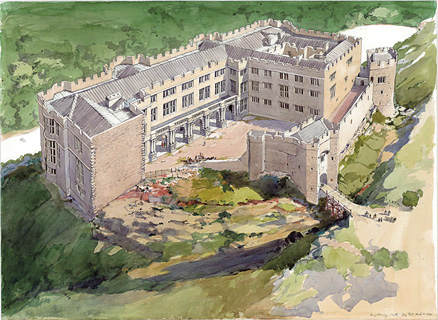
An artist’s impression of Berry Pomeroy Castle at its pinnacle of opulence (Image: English Heritage).
He transformed Berry Pomeroy into the ‘Beckingham Palace’ of its time, with its lavish grand staircase, it’s long galleries, its stunning views of the countryside through the vast full-height bay windows. Rooms were extravagantly decorated in carved and polished marble and alabaster. It had huge kitchens to feed the many guests who came to the parties thrown at the house. According to English Heritage’s guide book, “even unfinished, Berry Pomeroy became by far the grandest house in Devon, comparable with the contemporary great houses being built elsewhere by Jacobean courtiers”.
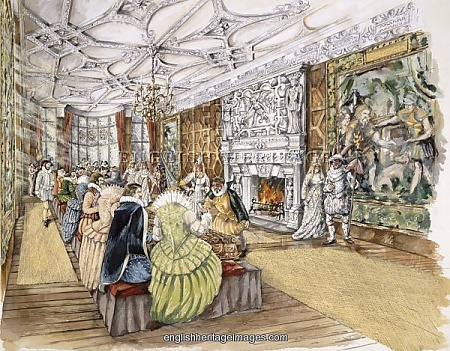
An artist’s impression of one of Edward Seymour II’s parties at the Castle (Image: English Heritage).
Trouble was, Edward was living beyond his means. Expensive failed lawsuits have been put forward as one reason for his sudden change in fortune and the work on the house coming to an abrupt halt. By 1611 he was in grave financial trouble, mustering enough cash to buy himself a baronetcy and die 2 years later a Sir. “All kinds of romantic tales have been invented for its incomplete state”, the guidebook goes on, “but the fact seems to be that Edward simply ran out of money”.
The house was held in the family for the next 80 years or so, as a succession of Seymour sons prospered, saw their fortunes wane, and fell in or out of favour with various kings and changes of national religious perspective. By 1689 all was fine, but then 10 years later, according to a history written in 1701, the Castle was “now demolished, and … Buried in its own ruins; there being nothing standing but a few broken Walls, which seem to mourn their own approaching Funeralls”. How come?
The then owner, the 4th baronet, had bigger fish to fry. He was building a new big house closer to London, the focus of his political aspirations, and he didn’t need Berry Pomeroy. As the guidebook says:
“The old, remote, unfinished mansion of Berry Pomeroy was of no use to him, except as salvage. Beams were removed, flagstone floors lifted, lead and tiles stripped from roofs and glass from windows, their lead being melted down”.
As the years passed the abandoned walls became covered in ivy and trees began to grow through the flagstones, and with the growth of the Romantic movement in the late 18th century, the Castle became a focal point for poets, artists and tourists, and ghost stories about what had happened there began to proliferate. As indeed they still do today: check out this very silly piece of US TV from a series called ‘SpiritSeekers’.
 So why am I telling you this story about an obscure Devon castle? I’ve done a lot of travelling over the last few weeks. I’ve been to London (several times), Manchester and Germany. About 3 weeks ago I was in Manchester speaking at a conference on Place Marketing and Place Branding, basically the art of attracting inward investment to your town, city or country (I urged a shift from thinking about “inward” investment to thinking about “internal” investment). I had spent the journey up reading the excellent new report by Dr Tim Morgan called ‘The Perfect Storm: energy, finance and the end of growth‘, published by FTSE 250 company Tullett Prebon. It’s stirring stuff. His analysis of why we have ended up in our current economic predicament runs thus:
So why am I telling you this story about an obscure Devon castle? I’ve done a lot of travelling over the last few weeks. I’ve been to London (several times), Manchester and Germany. About 3 weeks ago I was in Manchester speaking at a conference on Place Marketing and Place Branding, basically the art of attracting inward investment to your town, city or country (I urged a shift from thinking about “inward” investment to thinking about “internal” investment). I had spent the journey up reading the excellent new report by Dr Tim Morgan called ‘The Perfect Storm: energy, finance and the end of growth‘, published by FTSE 250 company Tullett Prebon. It’s stirring stuff. His analysis of why we have ended up in our current economic predicament runs thus:
“Fundamentally, what had happened here was that skilled, well-paid jobs had been exported, consumption had increased, and ever-greater quantities of debt had been used to fill the gap. This was, by any definition, unsustainable. Talk of Western economies modernising themselves by moving from production into services contained far more waffle than logic – Western consumers sold each other ever greater numbers of hair-cuts, ever greater quantities of fast food and ever more zero-sum financial services whilst depending more and more on imported goods and, critically, on the debts used to buy them. Corporate executives prospered, as did the gateholders of the debt economy, whilst the vast majority saw their real wages decline and their indebtedness spiral”.
He offers the best, and most to-the-point discussion of why energy return on energy invested (EROEI) matters, and why peak oil ought not be thought about as just the end of cheap energy, rather as the end of energy with a low EROEI. His point is best summed up when he writes:
“… the critical relationship between energy production and the energy cost of extraction is now deteriorating so rapidly that the economy as we have known it for more than two centuries is beginning to unravel”.
He adds that when the amount of energy we need to expend in order to maintain our access to useful energy passes a certain point, a point he argues that we have very nearly reached, “our consumerist way of life is over”. It is vital reading, especially the final chapter. I did try to get him to do an interview for Transition Culture, but unfortunately he is too busy on other projects.
The day after my talk I spent a couple of hours walking around Manchester city centre. It felt, rather like Edward Seymour II’s building adventures, like a huge project based on the wrong assumptions. It was clearly built on the assumption that the future would be one of growth and consumerism, driven by access to big brand shops, of cheap and easy credit and the long supply chains enabled by globalisation. Unfortunately that isn’t the future we’ve ended up with, and the coming years promise to be even less so.
I walked around the Arndale Centre, built to replace the previous one which the IRA blew to pieces in 1996, which is now Europe’s third largest city-centre shopping mall, a temple to shopping. Yet this was not the future assumed by the architects of what was, at the time, a big regeneration exercise. Pound Shop after Pound Shop, betting shops, it all felt rather down at heel and overtaken by events elsewhere. Outside the Arndale it was even worse, hardly the thriving prosperous commercial centre its designers had dreamt of.

Regeneration’ is one of those terms that is like motherhood and apple pie. Everyone wants regeneration, right? You’d be mad not to, surely. Yet all too often regeneration is about sweeping away the economy of local independent businesses and replacing it with big chains and brands. I’m sure if I found old photos of the centre of Manchester before it was ‘regenerated’ there would be a dazzling variety of independent businesses there, all now long gone or shunted out to the edge of the city.
A fascinating post by Karen Leach of Localise West Midlands on the REconomy site, gives a sense of why what she calls “community economic development” or on this website we might call REconomy or “community resilience as economic development” is so different from the current all-prevailing approach, and why it addresses our needs far better. Writing about their excellent recently published report ‘Mainstreaming Community Economic Development’, she summarises the report’s finding thus:
“Our research has found strong evidence that local economies with higher levels of SMEs and local ownership perform better in terms of employment growth (especially disadvantaged and peripheral areas), the local multiplier effect, social and economic inclusion, income redistribution, health, civic engagement and wellbeing than places heavily reliant on inward investment where there are fewer, larger, remotely owned employers.
Community Economic Development economies also support local distinctiveness and diversity, which we see as positives because of their contribution to economic resilience, economic options to suit a diversity of people, sense of place and belonging, area quality, added interest and richness of experience.
It found that a local economy largely controlled by ‘absentee landlords’ – distant private and public sector owners with little understanding of the local area – is a recipe for economic failure. Locally-inappropriate decisions and ‘footloose’ businesses leaving the area for better economic conditions seem to combine to weaken local businesses and create a self-reinforcing cycle of decline and exclusion”.
And yet still we allow our assumptions to underpin a push in completely the opposite direction. I recently went to speak at EcoBuild at the ExCel in London’s Docklands, the closest the UK has to a new urban district designed by Lego. Looking out from the train as I travelled through it, I could see countless little new shopping precincts, all hosting the usual chains, Tesco Metros and so on.
When I visited Berlin, it was saddening to see that Berlin Central Station is like a temple to chains too, the world’s ‘favourite’ brands all under one roof. Wouldn’t it be amazing to arrive somewhere by train, and to be able to walk around the station and instead of seeing all the same brands as in all the other stations you’ve visited around the country, to find something altogether different? It could be a station rich with pop-up food businesses, each selling locally made food that reflects the traditions and culture of that place, telling the stories of where that food came from, who prepared it, how your shopping there has helped local entrepreneurs and traders. How different an experience that would be. That the food outlets on offer celebrated diversity rather than uniformity. That your purchase was building local resilience rather than undermining it.
But at the root of all this are the assumptions we base our planning for the future on, the assumptions that underpin how we develop, what we develop and where we invest our money. Let’s compare German and British assumptions about the next 35 years or so. The German Federal Government have stated “[We] seek to cut electricity consumption by around […] 25% by 2050”, while UK Government has said: “In the longer term, by 2050, electricity demand is set to double, as we shift more transport and heating onto the electricity grid.” Germany’s assumptions are that its population will fall by 10% by 2050, the UK assumes a rise of 25%. Germany sees electricity demand per person falling by 15% by 2050, the UK sees demand rising by a staggering 65%. The UK Department for Transport also assumes that UK air travel demand will rise from 211 million passengers per year in 2010 to 520 million passengers per year by 2050.
As a result of these assumptions, Germany is in the middle of a renewable energy revolution, my recent train ride through the country being a delight for English eyes, huge PV arrays, onshore wind farms, renewables on the scale that can only be achieved when the might of the state is brought to bear. And over 50% of those renewables are in community ownership (as opposed to around 3% here). In the UK on the other hand, our assumptions are leading to our pushing relentlessly for economic growth led by housing, new airports, road and other infrastructure projects and downplaying renewables in favour of a new “dash for (fracked) gas”.
While we may be able to put Edward Seymour II and the designers of Manchester City Centre’s over-reaching themselves down to optimistic if not somewhat grandiose assumptions in terms of what the future would bring, we have no such luxury. We need to be basing what happens next on a realistic look forward. The Totnes & District Local Economic Blueprint, due out in a couple of weeks does just that (more on that soon). It argues that the jobs and new businesses of the future will come from looking at what we already do in a different way rather than pouring more money into inappropriate and debt-generating infrastructure.
We urgently need to shift away from planning for a future that isn’t going to happen and which, if we actively work to try and bring it about, will inevitably push us into disastrous climate change. We can do better than that. And if the people who should be doing that won’t do it, then it falls to us to take the initiative in our communities, and to do that now. It looks increasingly likely that in the future, in the same way that Victorian Romantics wandered around Berry Pomeroy Castle looking for the ghosts of louche Jacobean lords and ladies, our grandchildren may yet wander around the dishevelled remains of the temples of steel and glass that we erected at the end of the Age of Cheap Energy built on an almost superstitious belief that if we built them, our sheer belief, tenacity and will would enable us to overcome physics.
They will be hoping to catch sight of the rumoured ghost which people have reported as dashing past them, head down, clutching a Louis Vitton shopping bag. And whether we have warm, dry homes, meaningful work, a stable climate and vibrant communities to return to after our ghost walks will depend, in large part, on what we choose to spend our time over the next 20 years doing and the assumptions we choose to base that on.
I am indebted to the excellent English Heritage guidebook to Berry Pomeroy Castle for parts of this post. And to whoever invented the word “louche”.
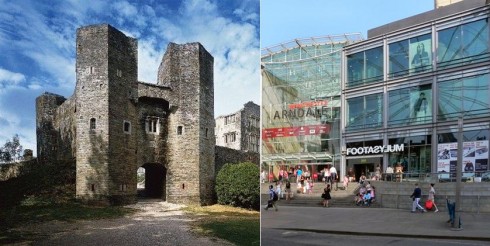
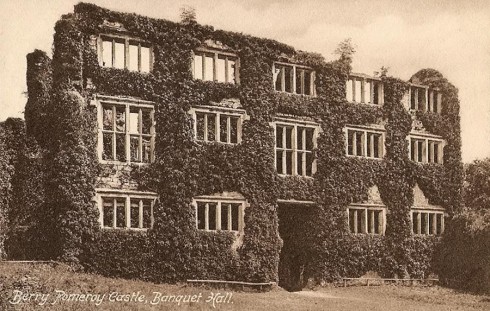
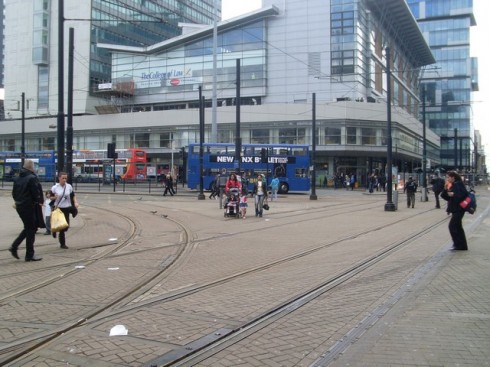
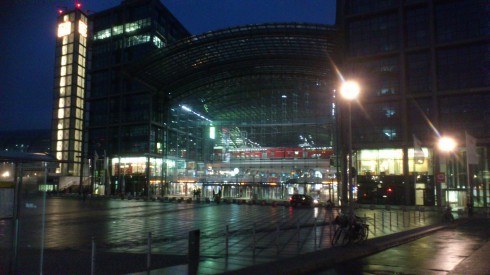
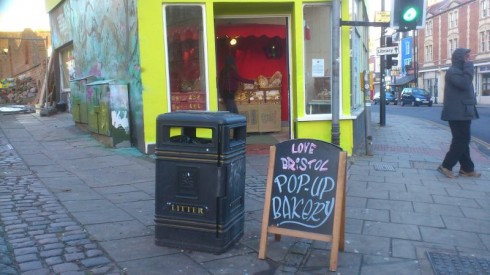
Miljenko
12 Mar 9:07am
Great post.
Please take look of Shell’s New Scenarios at http://www.shell.com/global/future-energy/scenarios.html.
old assumptions die hard.
Best
Miljenko
Marian van der Veen
12 Mar 10:27am
Wow, Rob, if ever there is a better evaluation of “status quo” present economic pump and circumstance and dito visions, looking with Dutch eyes, the same identical shopping centres present in the coastal urban parts of Holland, so far this post is fab. Thank you!
James Mac
12 Mar 11:04am
I walked around the Arndale Centre, built to replace the previous one which the IRA blew to pieces in 1996, which is now Europe’s third largest city-centre shopping mall, a temple to shopping. Yet this was not the future assumed by the architects of what was, at the time, a big regeneration exercise. Pound Shop after Pound Shop, betting shops, it all felt rather down at heel and overtaken by events elsewhere.
The “events elsewhere” include the Trafford Centre, which is larger and has acres of parking. I submit that that, far more than your theory, is why Manchester city centre is not thriving.
People aren’t getting the message about the need for change, and having attended a Transition meeting very recently I can understand why.
Paul Birch
12 Mar 11:19am
Rob,
I travel around the country (and sometimes beyond) a lot. I am sometimes depressed by the sameness of the places I go; experiencing the same feeling as you had arriving in Berlin Central Station. In the 1960s and early 1970s when I was a kid I sometimes travelled with my dad who was a lorry driver. One of the delights of this was the fact that every bit of the UK we travelled to was markedly different to every other. It wasn’t only the accents, it was the shops, the food, the whole feel of each and every community. Today I travel the country and know what I’ll find in and around the stations I arrive at and even in the towns and cities beyond. The sameness is an issue but your points about the sustainability of this is an even bigger one. Yes, we need to be working for a future that provides locally sourced, locally owned, locally supported economies and infrastructure.
Thank you!
Marian van der Veen
12 Mar 5:29pm
Ride on… I am an old ever young hippie… ahem. This is how I envision the (possibly near) future: one factor that will lead to variety, will be the collapse of present business as usual. A variety, I presume, as a wealth of creativity for optimists and a pain in the butt at first, for pessimists. How about (growing your own) foodsources on the land, signed, sealed and delivered on the spot, within a collective enterprise? Like in “The Real Dirt On Farmer John” movie? That one is a great example of transformation in unwielding assumptions and patience befriending wisdom in farming US.
Candy
13 Mar 5:37pm
“London’s Docklands, the closest the UK has to a new urban district designed by Lego”
I don’t think you’re being fair on Lego…
Caroline Walker
14 Mar 11:54am
The Perfect Storm report you mention is stunning, yet another interesting piece of work from Tullett Prebon. It was challenging and essential reading. Thanks for flagging it up. Has no-one in the government read it?
Gavinthornbury
14 Mar 3:28pm
German view of the future is probably based on November 2010, German Bundeswehr (‘Federal Defence Force’) confidential study by its Future Analysis department, which was leaked onto the Internet.
Translation of Bundeswehr Report on Peak Oil:
http://www.permabusiness.com/wp-content/uploads/2011/09/German-Bundeswehr-Peak-Oil_Study-EN.pdf
Plus a link to the similar 2010 report from the Pentagon’s Joint Operating Environment:
http://www.fas.org/man/eprint/joe2010.pdf
“…….By 2012, surplus oil production capacity could entirely disappear, and as early as 2015, the shortfall in output could reach nearly 10 MBD.”
(10 MBD – million barrels per day – represents the current production of Saudi Arabia, the world’s leading petroleum producer. Such a shortfall would be more than 10 percent of the world demand for crude, which is today 86.5 MBD, and is predicted to reach 90 MBD in 2015.)
Basically, it is common knowledge amongst governments that global GDP is expected to start decline from very approx. 2015 onwards.
Gavin
Shane
15 Mar 1:03am
A very fine post…
Marian
17 Mar 5:22pm
This is my comment regarding living in a bubble and consumerism online:
(forgive me for this rather long comment)
The insubstantial nature of virtual communication shows clearly in the similar nature of virtual money traffic, resulting in Low Jones and banking systems grinding into a standstill. The fleeting nature of both, the virtual world and virtual money, is entwined with the use of power, as we are witnessing now.
Money traffic flows in nanoseconds, cloaked in invisibility due to non – existence, bits and bytes of virtual deals, the glamour of banks, temples of doom for those lingering on the border of bankruptcy.
Many people nowadays answer to the call of deadlines like marionettes. Their nervous system is often threadbare, I’ve witnessed this as Nanny, in parents of families I worked with. The puppet players… holding the ropes, are invisible, as it should be…. in the theatre.
The sad truth of present day collective stress and thus… towering sickness absence, is the submission of many people to conditions that seem to offer freedom and glamour… a home.. or 2…..a car… or 2… a kid… or 2…. a flatscreen… or 2…..flashy clothes in neon light…. keeping up appearances and NOT lose face is guarded fiercely and a guarantee for success… which is a choice to many, or so it seems… until bankruptcy, adultery or death us do part.
While the costs of such a living soar high above the golden roof, the house is framed (pun intended) by invisible prison bars… with the bank as prison guard, holding the keys.
What a dream… never come true!
It reminds me of the fairy tale of “The emperor’s clothes”. Everybody around the emperor had to pretend he shone in regal colors, while 1 little boy simply exclaimed “But he’s got no clothes on!”
We’re the great pretenders, our society is only the reflection of it, when we don’t pay attention.
One successful way to stop paying attention and ignore daily life, ceasing to step into action, ignoring the beat of our own heart as an alarm bell, is being online much.
I’ve witnessed brilliant discussions, played my part in them and shared heartwarming words with virtual friends, for a couple of years, in fora. Unfortunately even more so, I’ve witnessed ranting and emotional high tides in disputes, never ebbing, due to being disconnected from daily life gut feelings, dealt with in contact(and touch) with fellow human being of flesh and blood.
I strongly believe that only then, there’s a chance for and an experience of “another” as a friend, a mirror, to feel a heart connection with a loved one, while looking into each other’s eyes. And to raise a glass together and laugh about a quarrel, silly in hindsight….. an opportunity that calls forth self reflection, confidential talks, in touch with daily life…. with its errands, its beauty, its mundane sides, to possibly birth new choices and the courage to step on new paths.
The virtual world is a safe haven, for those who long to lull their conscience asleep, or the pain of living… for that matter. It’s a walk on a tight rope, or a threadmill.
Pay attention to this loop: the virtual world of tv and pc, a very alluring make belief world, a convenient escape for those who choose to ignore the lively nature of their body, the beating of the heart, its call and the facts of present day life: the struggling economy, the decline of energy sources and the subsequent need for self-sustenance in the near future. Who choose to live in a bubble.
And as there’s safety in numbers… looking around, seeing a multitude of bubbles, doens’t spur us on for a change of heart, isn’t it?
And to be honest…who can blame us, living in that bubble of soap, compared to the state we’re in? Again, pay attention to that loop, the double bind relation with virtual reality. My dream coming alive, my Quest for Truth, has burst my bubble.
It threw me out of my comfort zone, the earth and my body welcome this life, this springtime, lady Gaia with me in friendship, as good comrades.
Josef Davies-Coates
20 Mar 2:37pm
Nice post, I just moved to Walthamstow where all sorts of good things are happening, but the Council’s ‘jewel in the crown’ (they actually call it that) of their regeneration project is a big new shopping centre. So sad.
Josef Davies-Coates
20 Mar 2:41pm
See e.g. this link
http://www.walthamforest.gov.uk/priorities
They literally define “regenerating the borough” as “Bringing you better shopping, streets and leisure”
Sigh.